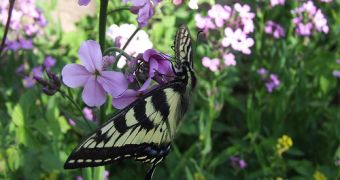All species are genetically programmed to ensure their and their offspring survival, so most genetic mistakes, that will produce catastrophic hybrids are avoided.
For animals or for insects, reinforcement – deterrence of hybrid mating, is quite easy to do, and a small difference in scent, plumage or mating rituals usually does the trick, but for plants, things are a big more complicated.
Since plants mate by pollination, they can't dance or choose their mates, so they had to come up with a new mechanism – in the case of common Texas wildflowers that share meadows and roadside ditches, color-coding does the job.
And the one that found the first evidence of a certain genetic change which allows two closely related wildflowers to avoid creating hybrids, is Duke University graduate student Robin Hopkins.
Along with her thesis adviser, Duke biology professor Mark Rausher, Hopkins found that one of the two flower species becomes tagged with a reddish color, so that it looks less appetizing to pollinating butterflies, that prefer blue.
Reinforcement keeps two similar proto-species apart from one another, by discouraging hybrid matings, and this looks like the first clear genetic evidence for reinforcement in plants. The two flower species are Phlox drummondii and Phlox cuspidata; in areas where Phlox drummondii lives by itself, it has a periwinkle blue blossom, but when it lives too close to the Phlox cuspidata (which is also light blue), its flowers appear darker and more red.
This anti-hybrid mechanism makes sense and it actually works, since some butterflies prefer light blue blossoms, so they will go from blue to blue an avoid the dark reds, while other butterflies prefer the reds and will stick with those.
This color preference prevents hybrid crosses, and since hybrid offspring between drummondii and cuspidata turn out to be nearly sterile, this is a very good thing.
Biologists knew that insects have color preferences, but they had not found the genes that were responsible for the color change.
Hopkins crossed a light blue drummondii with the red in greenhouse experiments, and she managed to identify these genes.
She discovered the offspring occurred in four different colors in the exact 9-to-3-to-3-to-1 ratios of classical Mendelian inheritance, and from there on, the did standard genetics to find the exact genes.
“It was 2 in the morning when I figured this out,) said Hopkins, “I almost woke up my adviser.”
The research showed that the change to red is caused by a recessive gene that stops the plant from producing its one blue pigment, while allowing it to continue with the other two red ones.
This 'defense' mechanism is not flawless, and even when red flowers are present, there are still nearly 11% of every generation that will be the nearly-sterile hybrids, but without it, the figures would be closer to 28%.
The mystery of the changing colors in flowers has been solved, and what now needs to be discovered is why and how the butterflies make the distinction.
“There are big questions about evolution that are addressed by flower color,” said Hopkins, who will be continuing her research as a visiting scientist at the University of Texas.
She will follow the clear message from all of her advisers – “follow the butterflies.
“Everyone wants to know more about the butterflies!"
For now, she has successfully defended her doctoral dissertation, and her work appeared in the journal Nature.

 14 DAY TRIAL //
14 DAY TRIAL //